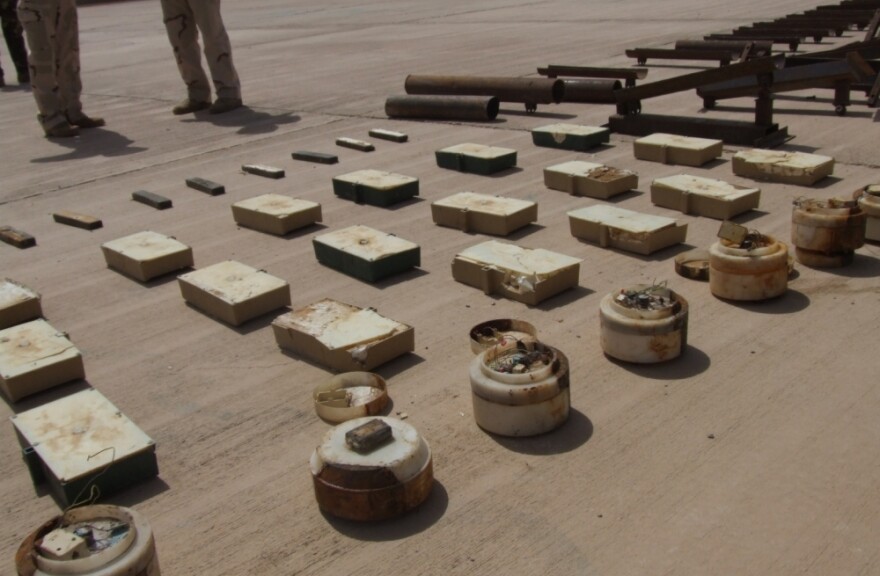Army Sgt. Maj. Todd Burnett spent about three years in Iraq hunting for improvised explosive devices, also knows as IEDs.
"I can remember going out and one week I got blown up three times," Burnett says. He says back then, it wasn't whether you were going to get blown up, it was just a matter of whenyou were going to get blown up.
The IED, which is essentially a homemade bomb, became the weapon of choice for the insurgency in Iraq. The U.S. has officially declared the end of the war there, but one lasting legacy will be the IED and how it changed the way the U.S. thinks about warfare.
Burnett is an Army combat engineer. Combat engineers are not the guys who actually disarm the bombs, but are instead the guys who clear the roads. They spot the IEDs in the first place.
"First of all we'd love to find the IED before it blows us up, but if not, our job was for it to blow us up rather than blow somebody else up that is in a less protected vehicles," he says.
The greatest producer of causalities on the battlefield in the 20th century was artillery, and my assessment is the IED is the artillery of the 21st century.
In the early years of the war, U.S. troops were driving around a lot in Humvees with little to no armor. Tony Cordesman, of the Center for Strategic and International Studies, says nobody was prepared for the insurgency. He's looked extensively at IEDs and how the threat took hold in Iraq and evolved.
"Initially [IEDs] were very crude; all you had to do was put a detonator on and you could turn a bomb or an artillery shell into what later came to be called an improvised explosive device," Cordsman says.
Year after year, the IED attacks in Iraq became more frequent and more deadly.
"As we developed better ways to patrol, they developed better ways to detonate," he says.
In 2007 alone, there were 33,900 IED attacks against U.S. troops. IEDs became the signature weapon for insurgents, who didn't have to stand and face a stronger, better-equipped U.S. military. Instead, they could plant these cheap devices on roads and foot paths. For American troops, one wrong step could be fatal.
"It wore on us very heavily because if somebody got hurt in our battle space by an IED, we took it very personal," Burnett says. "We always wondered after we go through, 'are they putting it in, or did we miss it?'"
In 2006, the Pentagon set up an office to deal with the worsening threat known as the Joint IED Defeat Organization. Their goal: get the protection and equipment that troops in the war zones need to deal with IEDs.
"We weren't created to go through some 3- or 4-year acquisition process. We are here to rapidly produce capabilities and we have been doing that," says Lt. Gen. Michael Barbero, the current director of the office.
Barbero says the impulse was to get the troops what they needed fast, no matter the cost. The money started to add up; this year's budget alone is $2.8 billion. Armored vehicles, high-tech surveillance gear, remote-controlled robots: all to fight a homemade bomb that costs about $30 dollars to make.
"A $31 bag of fertilizer and we're spending hundreds of millions of dollars on sensors and protective devices," says Barbero. "We've got to drive down the cost of dealing with this enduring threat."
Even with all of that money spent on technology, Burnett says the number-one tool on the battlefield is a well-trained soldier and his eyes.
"That's what's finding IEDs," he says.
And they'll be looking for those IEDs for a while to come. Barbero says just because the war is over in Iraq doesn't mean the threat goes away.
"The greatest producer of causalities on the battlefield in the 20th century was artillery, and my assessment is the IED is the artillery of the 21st century," Barbero says. "It is here to stay. Wherever our forces go, they're going to be dealing with this."
One place U.S. troops are still dealing with IEDs is not Iraq, but in Afghanistan, where they are still driving on uncleared roads, walking foot patrols and looking out for the dangerous, homemade explosives.
Copyright 2021 NPR. To see more, visit https://www.npr.org. 9(MDA4NjIwNTkwMDEzMjI4NDY0MjY4ZTBlNA004))




